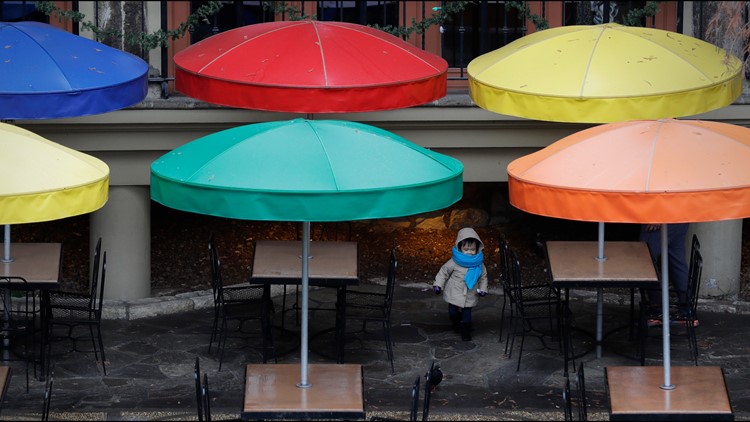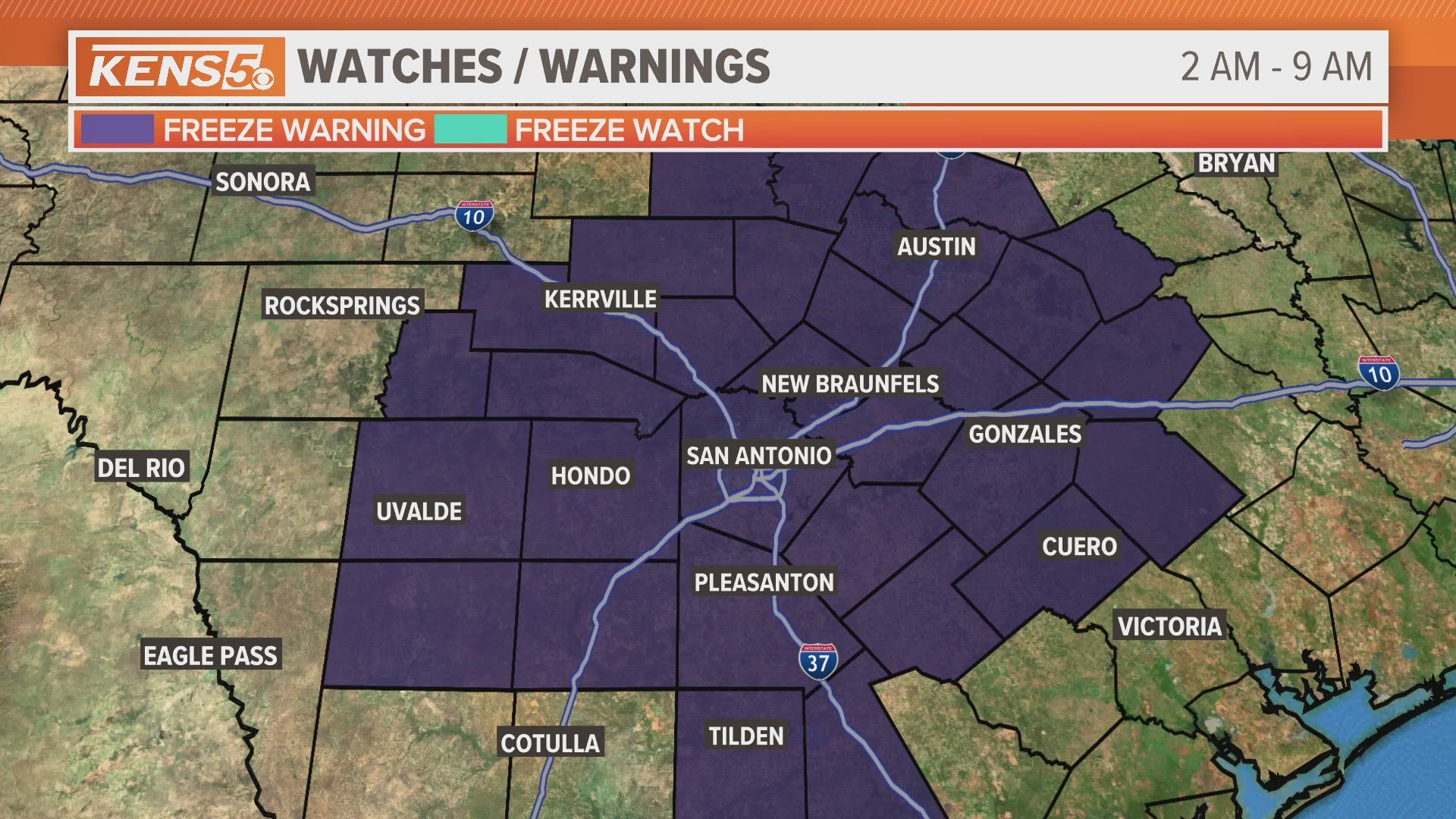SAN ANTONIO — San Antonio and the surrounding area are under a freeze warning overnight and into Monday morning, according to the National Weather Service.
The warning will cover large swaths of Central Texas through 9 a.m. on Monday, and the NWS says that temperatures will reach as low as 26 degrees in some places but should stay just above freezing for metro San Antonio and Austin. For many nearby areas this will be the first freeze of the winter.
"Frost and freeze conditions will kill crops, other sensitive vegetation and possibly damage unprotected outdoor plumbing," the NWS said in an alert Sunday. The warning was initially supposed to start at 2 a.m., but the NWS gave an update shortly after 11 p.m. Sunday starting the warning early because winds calmed down and temperatures dropped quickly.
To prepare for a hard freeze and protect your home, remember the four Ps: pipes, plants, pets and people. Below are some tips from the City of San Antonio:
To keep pipes from freezing:
- Wrap them up - If your pipes are exposed to the cold, wrap them up for insulation or use heat tape. You could even use fabric or newspaper to help.
- Keep it flowing - Allow a small trickle of water to run. The more faucets you keep running the better chances you keep pipes from freezing. Remember the cost of water is usually lower than fixing a broken pipe.
If your pipes do freeze:
- Shut off the water immediately - Don't attempt to thaw pipes without turning off the main-shut-off valve.
- Thaw pipes with warm air - You can try melting the frozen water in the pipe by warming the air around it with a hair dryer or space heater. However, be extra cautious with space heaters and do not leave them unattended.
- Be careful turning water back on - Once pipes are thawed, slowly turn the water back on and check pipes for any cracks or leaks that might have caused the freezing.
Pets
- Bring them inside. Pets, especially cats are safer indoors.
- If you can't have your pet inside, purchase an insulated doghouse or build a protective enclosure that shields your pet from the harsh outdoor elements.
- Certain pets are more vulnerable to cold temperatures such as shorthaired dogs, very young or old dogs, and all cats.
People
- Dress in layers and keep warm.
- Check on your elderly family or neighbors.
- The Homeless Connections Hotline number is 210-207-1799.
This is a developing weather event. Refresh the page for the latest updates.
SEVERE WEATHER 101
When severe weather threatens the area, it is important to know what risks a storm can bring and what you should do to stay safe.
One of the most important things to know is where you are located on a map, so when a watch or warning is put into place, you can identify if you are at risk. When the National Weather Service puts out warnings, they are county-based and sometimes include cities as well. It is important to know where you live in the county and that you can identify it on a map.
It is also important to know the difference between a watch and a warning. A watch means that conditions are favorable for something to happen, but a warning means that something has developed and it is important to take action.
So, what would cause a thunderstorm to be qualified as a "severe" thunderstorm?
Hail that is one inch large is also considered to be about the size of a quarter.
Another ingredient that would lead to a storm becoming severe is if winds are 58 mph or greater.
Winds at this strength could cause damage to roofs and could even cause trees to be knocked down.
Finally, if a tornado is present inside a thunderstorm it would qualify the storm as becoming severe.
In this instance, a tornado warning would be issued.
A tornado watch can be issued for an area if strong storms are expected, and if the storms bring the risk for tornadoes, but not all storms include the threat for tornadoes. The ingredients in the atmosphere for a tornado to form are not always there when storms are present.
If the area you are in is ever under a tornado warning, it is important to know where you should go inside your home.
Head to the lowest, interior room of your home. The basement would be best, but if you don't have one, head to the first floor of the home and get away from exterior walls, or walls that lead to the outside of the home.
It is also important to stay away from glass. The more walls you can put between you and the outside, the better.
While lightning can be frequent in storms and very dangerous, it does not lead to a storm being qualified as severe.
Remember, when thunder roars, go indoors.
Storms can also lead to flooding. Flooding may not cause a storm to be labeled as being severe, but it is the deadliest kind of weather.
South Texas is known to have major flood events every few years, so it is important to use caution and to always stay out of floodwaters. Remember, turn around, don't drown.
Entering flood water is very dangerous as you can be swept off of your feet and you don't know what could be in the water that could hurt you.
The best thing you can do to be ready for severe weather is know what you will do in the event it strikes where you live.
Make sure your family has a severe weather action plan.
Have a place everyone goes inside your home and keep supplies there, such as food, medication, batteries, and flashlights.
Weather Minds Classroom: Take a class in Severe Weather 101
Follow the KENS 5 Weather Team
Don't forget you can download the KENS 5 app for the latest news and weather information each day while you are on the go.




